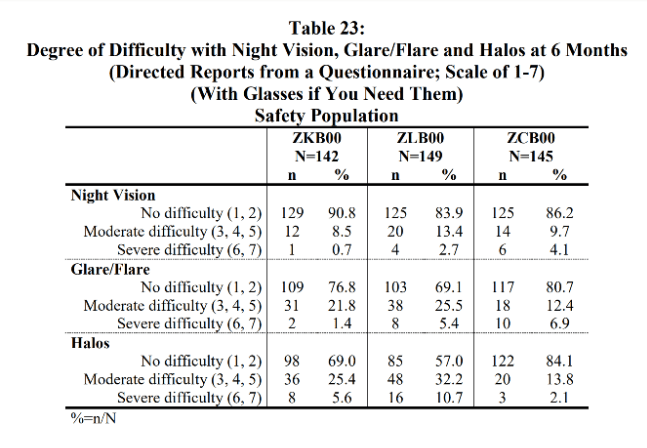The Tecnis Multifocal Lens implants are some of the most popular advanced technology. They help patients having cataract surgery and custom lens replacement achieve outstanding glasses-free vision for both distance and near vision.
We’re going to tell patients everything they need to know about these implants if they’re considering a future free from glasses.
What are the Tecnis Multifocal Implants?
The Tecnis multifocal implants are intraocular lenses (IOL) that are used in cataract surgery or lens replacement procedures. They are designed to improve vision at multiple distances and reduce the need for glasses or contact lenses after surgery.
They come in two models, the ZLB00 and the ZKB00. These models each are set for a slightly different near focal point.
The ZLB00 has an “add power” of +3.25 (in the IOL plane).
The ZKB00 has an “add power” of +2.75 (in the IOL plane).
Because the ZLB00 has a stronger add power, the near “sweet spot” of the ZLB00 is a little closer than the ZKB00. Depending on your activities, lifestyle, and how close you like to hold things, one of these may be preferable for you.
The Tecnis multifocal IOL is a good option for patients who want to reduce their dependence on glasses or contact lenses after surgery. It is particularly useful for patients with presbyopia, a condition that causes the natural lens of the eye to become less flexible and less able to focus on objects at close range.
How Do the Tecnis Multifocal IOL’s Work?
During cataract surgery or lens replacement, the natural lens of the eye is replaced with an artificial lens implant (IOL). The Tecnis multifocal IOL’s diffract, or split, light into multiple focal ranges. This results in freedom from glasses for both distance vision and near vision.
How Do the Tecnis Lens Implants Differ From Other Advanced Implants?
The Tecnis Multifocal Lens Implants are a multifocal with 2 relatively distinct focal points. Other presbyopia correcting IOL’s may be trifocals or extended depth of focus lenses. The difference is in how these lenses split light.
There is no advanced implant that is “the best” for everyone. The right lens implant for you should be determined in consultation with your doctor. You should factor in your vision goals, lifestyle, and overall ocular health.
Are There Patients Who Should Not Get a Tecnis Multifocal IOL?
Like other advanced technology lens implants, there is no one lens implant that is best for everyone. There are several reasons that patients may not be good candidates for a Tecnis Multifocal lens implant.
Some of the more common reasons are the following:
- Corneal abnormalities, such as severe dry eyes, irregular astigmatism, or Fuchs dystrophy
- Glaucoma
- Retina disease (e.g. macular degeneration, diabetic retinopathy)
- Optic nerve disease
There are many patients with mild retinal or corneal conditions, such as dry eyes, who do great with multifocal implants. However, it is believed that these patients can be at greater risk for having unwanted reduced quality of vision.
Discuss this with your doctor if you have these conditions or are interested in a multifocal implant.
Are There Risks or Side Effects of the Tecnis Multifocal Implants?
Glare, halos, and difficulty with night vision can be unwanted side effects of the Tecnis Multifocal lens implants in a small number of patients.
Glare, Halos, and Night Vision Symptoms
In the FDA’s clinical trial, they looked at glare, halos, and night vision symptoms in the ZKB00 and ZLB00 implants. These multifocal implants were compared to the ZCB00 monofocal implant. Here’s what they found:
Remember, the “ZCB00” is the control monofocal lens implant. It is widely regarded as one of the best monofocal lens implants on the market.
Interestingly, more patients had severe difficulty with night vision in the control ZCB00 group compared to the multifocals. Excellent news for the multifocals here!
In terms of “glare”, once again, more patients in the control group had severe difficulty with glare. However, more multifocal patients had moderate difficulty with glare. Overall, the majority of patients in all groups had “no difficulty” with glare.
For halos, more multifocal patients experienced them. This seems to be the most common quality of vision side effect at 6 months from the FDA clinical trial.
Do the Tecnis Multifocal Implants Fix Astigmatism?
Yes they do! The Tecnis Multifocal implants do correct astigmatism. Your surgeon will take measurements on your eyes to determine if it is best to correct your astigmatism with the lens implant, or by another method.
How Much Do The Tecnis Multifocals Cost?
The Tecnis Multifocal implants are not covered by medical insurance. They require an out-of-pocket payment which can range from $4,000 to $5,000 per eye, but varies by practice.
Does Medicare Cover the Tecnis Multifocal IOL?
No. Medicare does not cover any multifocal IOL’s, including the Tecnis Multifocal implants.
However, if you select a multifocal implant, Medicare will still pay for the surgeon fee, anesthesia fee, and surgical center facility fee.
The Tecnis Lens Implant Review Summary: Is It Right For You?
In summary, the Tecnis Multifocal lens implants are safe and effective advanced lens implants to reduce your need for glasses after cataract surgery. They provide excellent distance and near vision. They come in two models which have slightly different near points, which can be customized to your eyes.
If you’re interested in being free from glasses after your cataract surgery, the Tecnis Multifocal implants may be right for you. Discuss with your doctor if you are a good candidate for them.
Source: fda.gov












